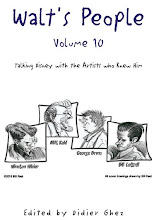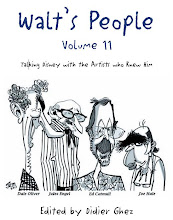What
is Call Me Walt?
“He was a lot shaggier in real life than he appeared in a nice pressed suit
on television,” said his nephew Roy. “He
was a pretty casual dresser and didn’t pay a hell of a lot of attention to
whether his hair was combed or not.”
By
Jim Korkis
My
most recent book, Call Me Walt: Everything You Never Knew About Walt Disney (Theme
Park Press 2017) was inspired by a seemingly simple question:
Who
was Walt Disney?
Amazingly,
that is a much more difficult question to answer than many people imagine. After all, there are dozens of biographies
about Walt Disney both in English and multiple foreign languages as well as
additional references to his life in countless other books.
Magazines
and newspapers for decades have published a summarized overview of Walt’s
life. Even The Walt Disney Company
beginning in the 1930s had a pre-printed, multi-page biography to give out to
journalists. Walt himself often gave
interviews to reporters or made speeches where he recounted his life.
We
all know the story of the poor Midwest farm boy who only attended one year
of high school and went on to become an entertainment legend thanks to his
dreams and hard work.
Yet
all of those accounts have the same fatal flaw.
As TV Guide writer Edith Efron
wrote in her July 17, 1965 article about Walt: “(Walt’s)
accomplishments are unnecessary to list.
There can be few people in this country who have not been exposed to
some of them. If his name and
achievements are a matter of household knowledge, the man behind the name is
not. The fascination of his activities
have tended to divert eyes from the man engaging in them.”
When we think about Walt,
we all immediately think about Mickey Mouse and his animated friends, Snow
White and the Seven Dwarfs (1937), Disneyland, Audio-Animatronics and
similar milestones that transformed not only entertainment but the entire
American culture.
Despite his showmanship
and being in a bright spotlight most of his life, Walt Disney the man himself
is still a mystery to almost everyone.
Where did he buy his
clothes? What different cars did he
drive? Did he also have cats as pets
besides dogs? What charities did he
donate to without fanfare? Did he
believe in God and did he pray every day?
What did Walt and Lillian like to do on warm summer evenings with great
frequency? What two television game
shows did they love watching in the evening as they ate on trays?
What were Walt’s political
views? What things did he do with his
grandchildren that they still remember vividly fifty years after he died? How much did Walt Disney weigh? Who was his ophthalmologist who prescribed reading
glasses that Walt never wanted to be photographed wearing?
The answers to all those
questions and many, many more like them are in the book along with
documentation.
Since his death, Walt has
come under many attacks but those vicious misrepresentations are often at the
brand that Walt created around the name “Walt Disney” rather than the man
himself who remained very private and hidden from just about everyone.
I felt it was time for a
book that concentrated on Walt and not his accomplishments. So my book features no mention of Mickey
Mouse or Disneyland.
It does, however, point
out that he had a box at Santa Anita horse race track (along with one at the
Hollywood Park race track) that he frequented as well as one at Dodger Stadium about three rows up behind
first base.
While Walt was concentrating on the
Florida Project, Mineral King, California Institute of the Arts, Mary
Poppins (1964) and so much more, he was spending a good deal of his time
participating in lawn bowling tournaments with his hand-tooled
bowling bag.
Even today, there is an
annual international lawn bowling tournament that awards a four-foot tall perpetual
trophy made of solid Brazilian redwood with imbeds of Walt’s four personal lawn
bowls along the base and is topped by a golden foot-high Mickey Mouse figurine.
The book is not another
biography. It is not chronological. It is not definitive. Every chapter is
self-contained like many of my books.
The book is about Walt as
a person, a son, a brother, a husband, a father, and a grandfather. While I freely admit I have great fondness
and respect for Walt and that may influence the tone of the text, it did not
prevent me from simply stating the facts both good and ill. Several chapters are devoted to his flaws
from his temper to making fun of others.
I have included twelve
chapters to debunk some of the most common myths about Walt including that he
was frozen, born in Spain, was racist, dishonorably discharged, an FBI
informant, a freemason and more.
The foreword to the book is by Disney
Legend Floyd Norman who among other things shared: “I personally never saw any
racist behavior or words from Walt. When
I was there in the 1950s and 1960s, I knew Claude Wilson who was the black
janitor at the studio. A janitor is pretty much invisible in that people never
pay much attention to him so he was able to overhear uncensored conversations
as he was cleaning up. He never heard
Walt being racist or others talking about Walt being racist.
“He also moonlighted as a
bartender at many
of Walt’s parties when they were held at Walt’s home in Holmby Hills. This older black gentleman who ran the bar
always spoke well of Walt and loved working for him. Since we spoke privately, had there been
anything to indicate racism, this old guy would have made his feelings known to
me to warn me to be careful. I was
always struck by Walt’s openness, fairness and honesty.”
The more I tried to uncover Walt
Disney, the more surprises I encountered.
Disney Legend Van France
remembered in 1991 his first meeting with Walt, “Somehow I'd imagined that Walt
Disney would have the soft, delicate hands of an artist drawing Mickey
Mouse. But my hand met the firm grip of a man who had grown up doing hard
farm labor and working for his father in construction.”
One of Walt’s favorite pastimes when
he went to the mountains to ski was ski-joring [a winter sport where a person
on skis is pulled by a horse, a dog (or dog team) or a motor vehicle] and so
that activity might have ended up at the never completed Mineral King ski
resort. Walt still owned shares in the
Sugar Bowl ski resort as the time of his death.
I dedicated the book to Walt’s late
oldest daughter Diane Disney Miller who was so supportive of my writing and
getting out the true stories about her father.
I quote extensively from our conversations and e-mails including:
“I don’t think anybody really knows him anymore. His name
is so familiar and the brand is everywhere. As a daughter, I have been very
upset by things that have been written and said about him that were not
true. He was my trusted friend. I could tell him anything and everything and
know that he would understand. He loved
being a daddy and a grandather.
“I remember going through Dad’s dresser drawers one time looking
for something. He kept things in them
like a collection of matchboxes and soap packages from hotels and I used to
find those fascinating. I found a
newspaper clipping one time with the headline on it about his mother’s
death. He would never talk about her
death.”
This
book may not really be everything you never knew about Walt but it is filled
with many things that are usually not covered elsewhere with some items that
may still surprise even the most diligent Walt scholar. If this type of information interests you,
you may want to consider putting the book on your list to Santa this year.
The striking cover was done by talented animator, cartoonist and
director Dave Bennett and was inspired by a similar sketch he did for the
animation fanzine Animato! #10 (1986) with some significant changes.























2 comments:
That's a long review. o.O
But I don't have to read this one to know him better; I
already have, through official biographies and a little
imagination. I believe he was a warm and kind person, a
loveable man and a playmate. Sometimes I use his quirks
to be like him, like ad-libbing while reading fx.
...Heh, my Movember-beard even looks like his trademark
at the moment.
I don't blame him for keeping the newspaper clipping
about his mother's death and not talk about it, even
though I don't understand this. Is it because he blames
himself for the accident, that he hides it away in his
closet? That's what I think
Jim: I look forward to reading your latest from your unceasing research. Thanks for your excellent work.
Post a Comment